
Concept explainers
(a)
Interpretation:
The product for the reaction between
Concept introduction:
The reaction in which one form of an ester is converted to another form by changing the carbon skeleton of the alkoxide part (OR) of the ester is called transesterification. The transesterification reaction is a nucleophilic addition-elimination reaction. In the first step, the nucleophile adds the electro-poor carbonyl carbon of the ester, which forces the bonding pair of carbonyl p bond onto the O atom. A negative charge is produced on that O, and a tetrahedral intermediate is formed. In the second step, tetrahedral intermediate undergoes nucleophilic elimination to form the transesterification product. The transesterification is a reversible reaction. The base hydrolysis of an ester to produce corresponding
Answer to Problem 20.28P
The product for the reaction between

The complete detailed, mechanism for the given reaction is
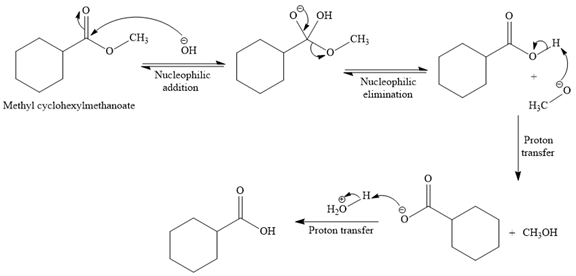
Explanation of Solution
The given reaction is
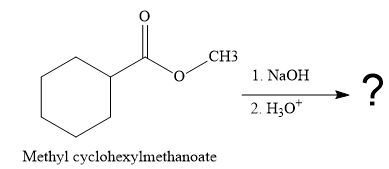
So this is a saponification reaction of

In the second step, nucleophilic elimination takes place to produce an alkoxide ion and corresponding carboxylic acid. These steps are reversible.
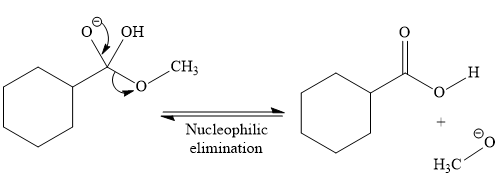
In the third step, irreversible deprotonation of the carboxylic acid takes place and the carboxylate ion is formed. Finally, on acid workup step, protonation of the carboxylate ion takes place to form the carboxylic acid.

Thus, the products of the given reaction are
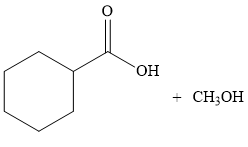
The product is predicted by using transesterification concept and the detailed mechanism is drawn.
(b)
Interpretation:
The product for the reaction between
Concept introduction:
The reaction in which one form of an ester is converted to another form by changing the carbon skeleton of the alkoxide part (OR) of the ester is called transesterification. The transesterification reaction is a nucleophilic addition-elimination reaction. In the first step, the nucleophile adds the electro-poor carbonyl carbon of the ester, which forces the bonding pair of carbonyl p bond onto the O atom. A negative charge is produced on that O, and a tetrahedral intermediate is formed. In the second step, tetrahedral intermediate undergoes nucleophilic elimination to form the transesterification product. The transesterification is a reversible reaction. The base hydrolysis of an ester to produce corresponding carboxylic acid and alcohol is called a saponification reaction.
Answer to Problem 20.28P
The product for the reaction between
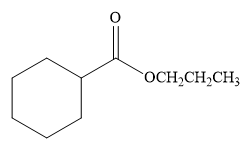
The complete detailed, mechanism for the given reaction is

Explanation of Solution
The given reaction is
This is a transesterification reaction of

In the second step, the tetrahedral intermediate undergoes nucleophilic elimination to form the transesterification product.

Thus, the product of the given reaction is

The product is predicted by using transesterification concept and the detailed mechanism is drawn.
(c)
Interpretation:
The product for the reaction between
Concept introduction:
The reaction in which one form of an ester is converted to another form by changing the carbon skeleton of the alkoxide part (OR) of the ester is called transesterification. The transesterification reaction is a nucleophilic addition-elimination reaction. In the first step, the nucleophile adds the electro-poor carbonyl carbon of the ester, which forces the bonding pair of carbonyl p bond onto the O atom. A negative charge is produced on that O, and a tetrahedral intermediate is formed. In the second step, tetrahedral intermediate undergoes nucleophilic elimination to form the transesterification product. The transesterification is a reversible reaction. The base hydrolysis of an ester to produce corresponding carboxylic acid and alcohol is called a saponification reaction.
Answer to Problem 20.28P
The product for the reaction between
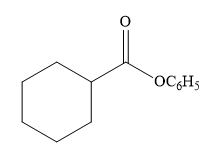
The complete detailed, mechanism for the given reaction is

Explanation of Solution
The given reaction is
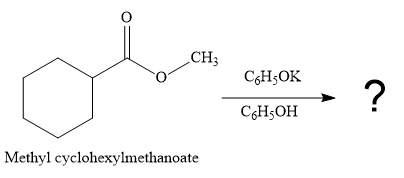
This is a transesterification reaction of the

In the second step, tetrahedral intermediate undergoes nucleophilic elimination to form the transesterification product.

Since phenoxide ion (
Thus, the product of the given reaction is

The product is predicted by using transesterification concept and the detailed mechanism is drawn.
Want to see more full solutions like this?
Chapter 20 Solutions
ORG CHEM W/ EBOOK & SW5 + STUDY GUIDE
- Part VII. Below are the 'HNMR 13 3 C-NMR, COSY 2D- NMR, and HSQC 20-NMR (Similar with HETCOR but axes are reversed) spectra of an organic compound with molecular formula C6H13 O. Assign chemical shift values to the H and c atoms of the compound. Find the structure. Show complete solutions. Predicted 1H NMR Spectrum ли 4.7 4.6 4.5 4.4 4.3 4.2 4.1 4.0 3.9 3.8 3.7 3.6 3.5 3.4 3.3 3.2 3.1 3.0 2.9 2.8 2.7 2.6 2.5 2.4 2.3 2.2 2.1 2.0 1.9 1.8 1.7 1.6 1.5 1.4 1.3 1.2 1.1 1.0 0.9 0.8 f1 (ppm)arrow_forward3. Draw the expanded structural formula, the condensed structural formula, and the skeletal structural formula for 2-pentene. expanded structure: Condensed structure: Skeletal formula: 4. Draw the expanded structural formula, the condensed structural formula, and the skeletal structural formula for 2-methyl-3-heptene. expanded structure: Condensed structure: Skeletal formula: following structurearrow_forwardPart IV. Propose a plausible Structure w/ the following descriptions: a) A 5-carbon hydrocarbon w/ a single peak in its proton decoupled the DEPT-135 Spectrum shows a negative peak C-NMR spectrum where b) what cyclohexane dione isomer gives the largest no. Of 13C NMR signals? c) C5H120 (5-carbon alcohol) w/ most deshielded carbon absent in any of its DEPT Spectivaarrow_forward
- 13C NMR is good for: a) determining the molecular weight of the compound b) identifying certain functional groups. c) determining the carbon skeleton, for example methyl vs ethyl vs propyl groups d) determining how many different kinds of carbon are in the moleculearrow_forward6 D 2. (1 pt) Limonene can be isolated by performing steam distillation of orange peel. Could you have performed this experiment using hexane instead of water? Explain. 3. (2 pts) Using GCMS results, analyze and discuss the purity of the Limonene obtained from the steam distillation of orange peel.arrow_forwardPart III. Arrange the following carbons (in blue) in order of increasing chemical shift. HO B NH 2 A CIarrow_forward
- 6. Choose the compound that will produce the spectrum below and assign the signals as carbonyl, aryl, or alkyl. 100 ō (ppm) 50 0 7. 200 150 Assign all of the protons on the spectrum below. 8. A B 4 E C 3 ō (ppm) 2 1 0 Choose the compound that will produce the spectrum below and assign the signals to the corresponding protons. OH 6 OH 3 2 1 0 4 ō (ppm)arrow_forwardIn the Thermo Fisher application note about wine analysis (Lesson 3), the following chromatogram was collected of nine components of wine. If peak 3 has a retention time of 3.15 minutes and a peak width of 0.070 minutes, and peak 4 has a retention time of 3.24 minutes and a peak width of 0.075 minutes, what is the resolution factor between the two peaks? [Hint: it will help to review Lesson 2 for this question.] MAU 300 200 T 34 5 100- 1 2 CO 6 7 8 9 0 2.4 2.6 2.8 3.0 3.2 3.4 3.6 3.8 4.0 4.2 4.4 4.6 4.8 5.0 5.2 Minutes 3.22 0.62 1.04 O 1.24arrow_forwardThe diagram shows two metals, A and B, which melt at 1000°C and 1400°C. State the weight percentage of the primary constituent (grains of C) that would be obtained by solidifying a 20% alloy of B. 1000°C a+L L+C 900°С 12 α a+C 45 1200 C L+y 140096 C+Y a+ß 800°C 700°C C+B 96 92 a+B 0 10 20 30 40 50 60 70 80 90 100 A % peso B Barrow_forward
- 8. Choose the compound that will produce the spectrum below and assign the signals to the corresponding protons. 2 4 3 ō (ppm) OH 4 6 6 СОН 2 1 0arrow_forward7. Assign all of the protons on the spectrum below. A B 2 C E 2 1 3 6 4 3 2 1 0arrow_forwarde. If (3R,4R)-3,4-dichloro-2,5-dimethylhexane and (3R,4S)-3,4-dichloro-2,5-dimethylhexane are in a solution at the same concentration, would this solution be expected to rotate plane polarized light (that is, be optically active)? Please provide your reasoning for your answer. [If you read this problem carefully, you will not need to draw out the structures to arrive at your answer...]arrow_forward
